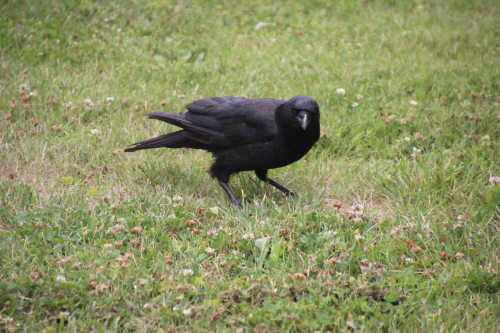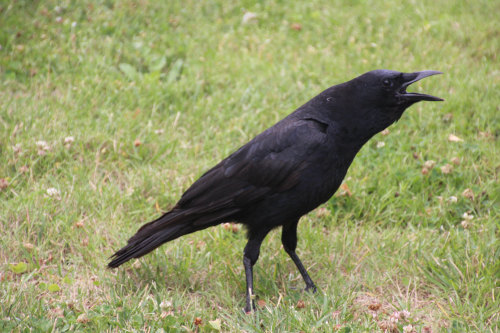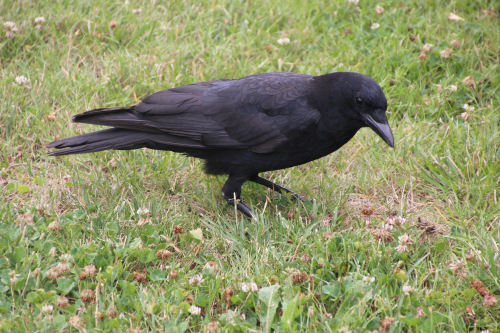I’m trying to write a fantasy story from the point of view of a crow. Actually, that is the only fantasy element in the story; otherwise it’s pretty mundane.
There are three ways to go about this.
Option One; bag the whole idea and don’t do it, which I must admit looked pretty attractive at times.
Option Two; gird my figurative literary loins, pour myself a glass of gold-medal wine, put on the earphones and write my best high-falutin’ poetical prose, then toss in a few crowisms. “Oh, how I longed for my nest of sticks, fluffed with down plucked from my mother’s own breast, for despite my brilliant vocabulary and trenchant observations of humanity, I was, first and foremost, a crow!” It’s like giving the soprano a nice headdress of feathers and having the audience agree to pretend to believe she’s a crow. It’s surprising how well this technique works, particularly in the literary world.
Option Three; read about crows; watch crows; try to stretch my imagination to conjure what the world would be like for a creature that is nothing like me.
Of course I picked the really hard one.
As near as I can tell, there are three two parts to Option Three. Part One; the imagine the world thing; and Part Two, decide how much cheating I’m willing to do. Actually, I have those reversed. Cheating comes first.
The whole story is a cheat, of course. I’m a human writer, not a crow with fingers. I can’t penetrate the mind of the crow, if a crow can be said to have a “mind,” (or if I can even be said to have one). I can only try to share an imagined vision of how a crow might function given a particular set of circumstances.
Where I Cheat:
Like a Crow, I Take Stuff
Corvidae (crows, ravens and jays) are the source of tons of folklore and a goodly amount of scientific information. Where it’s convenient, I use documented scientific information. Where the folklore is more interesting and useful, I snap it up without hesitation. For example, folklore about crows is that they recognize a dead crow, and react by going silent. This idea romanticizes an unscientific, un-quantified observation, and I don’t care. I like it. I can use it.
There is well-documented behavioral evidence that crows recognize faces, and can associate a face with a positive/negative experience. Crows murmur to a person who has brought them food; they sound the alarm when the human who grabbed then and banded them appears on the scene. I can certainly use that.
There is folklore that crows will stay away from a place where bad things happened to other crows, sometimes, the old folks say, for up to two years. I’m definitely grabbing that one.
Bright and Shiny Things
Because I don’t have dialogue in the story (there’s crow-speak, but it’s largely un-translated) and I can’t spend a lot of time in the crow’s head delineating motivation, I rely on physical descriptions and action sequences. Crows see deeper into the spectrum than we do. This doesn’t mean that they experience all colors differently, but that didn’t stop me from loading up the story with colors. I do not think that crows fly through a designer-hued world, thinking, “The sky is cerulean today, and that peach is the mother-of-pearl-in-firelight color that connotes perfect ripeness.” I have, however, boot-strapped the color issue into a story that, I hope, flashes and glitters with color, and bulges with sensuous detail.
How I Cheat Less:
Trying to Think Like a Crow:
From the beginning, the crow in my story is motivated by a human emotion (I don’t think a crow would make the choice she does at the beginning). As soon as I get past that, though, I want the thought processes in the story to seem like they are coming from a crow. The crow has to describe things so that the human reader knows what’s going on, even though the crow doesn’t.
I started with a list. This started off easy and got difficult.
Would a crow recognize wood? Yes.
Would a crow recognize stone? Yes.
Would a crow recognize metal? Yes (a leap, but one I’m comfortable with).
Would a crow recognize coins? The shape? Yes. The purpose? No. Coins are currency. I don’t see anything comparable in the crow experience. If, however, the crow sees metal disks given to one human, and sees an item given in exchange, the human reader will probably surmise that this was a financial transaction.
Would a crow understand that human character A was the second cousin of human Character B? No. Unlike the coin thing, I cannot think of any interaction that would scream “second cousin” to a human reader. It’s a good thing I don’t need a second cousin in the story.
Would crows recognize clothing? No. Or, well… maybe. And now it gets tricky. An experienced urban crow might make some distinctions about clothing. My crow is a young crow, newly arrived in a human city. I think she would not. This leads to…
Would a crow recognize human gender? Well, I can’t differentiate gender in crows just by looking at them. In the story, though, the crow needs to make some differentiation so that the reader knows who’s who (or, who’s what, I guess). It only matters in one case, but there are two human characters, so I have to sex each of them. I try to have the crow decide on gender (correctly) by observing behavior. And then I cheat and just say the male has “feathers on his face.”
One observation: human readers are shockingly species-centric. The story isn’t about them, but they still want to know all about the human characters. I had a non-fantasy-reader argue with me that because the crow doesn’t figure out the gender of Human Two until later in the story (from behavior) that I “wasn’t playing fair with the reader. We should know right away.” There isn’t any story-based need to know right away. If a large cat were attacking a crow nest full of chicks, would the crows be interested in the cat’s gender? Probably not. After going through my bristle of indignation, (“Not playing fair, madam? Not playing fair? You try doing this!”) I realized that this is egocentric nature of humans—they want to know about the humans. So if there is an easier way to let the reader know Human Two’s gender sooner, I will do it, just so people stop wondering and pay attention to my crow.
Is the story successful? I guess we’ll know when I start sending it out. It was difficult. It was kind of fun. Does it work? Time will tell.




I think a blend of two and three would work well. As a reader, I appreciate a writer’s research, but in terms of fiction I’m looking for story first. I think some writer’s get bogged down in the details about what they have learned and inadvertently highlight their research more than their story. I stop reading those stories very quickly.
“Option Two; gird my figurative literary loins, pour myself a glass of gold-medal wine, put on the earphones and write my best high-falutin’ poetical prose, then toss in a few crowisms. ” Start there and comeback the next day with no wine and work with it.
You can write with headphones? Music? Amazing.
Frankly, I think it’s a bit of a blend now since I use a lot of physical description, lot of color, lots of texture. (I hope so, anyway). Towards the end it bogs a bit, because everything has to be “interpreted” through the crow.
The headphones were kind of a joke. I do wear them when Spouse is home because they cut ambient noise but I don’t usually play music. Sometimes, though, music does help the writing process — I was listening to Beethoven this morning — but other times it is too distracting. It’s day-by-day.